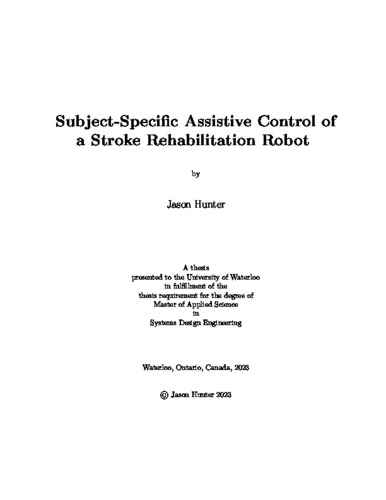| dc.description.abstract | The branch of medicine known as rehabilitation involves an injured patient employing repetitive practices under the supervision of a physiotherapist in an effort to help the patient recover motor control. But during stroke patient rehabilitation, therapists lack objective measures of the subject’s movement performance unless sensors/markers are physically placed on the subject’s body, which can often present an inconvenience and lack of tangible benefit to the subject. Without removing the need for physiotherapists, rehab robots can assist in improving the patient’s performance during repetitive movements. The goal of this research is to focus on the symbiosis between the patient and robot such that the rehabilitation exercise is tailored to each specific patient’s needs; subject-specific assistive control of rehab robotics evaluates the user’s voluntary motion, from which robotic assistance is then tailored based on the user’s ability or performance.
The end-effector-based robot used in this study is an actuated 2-degree of freedom (DOF) 4-linkage planar parallelogram manipulator. To measure the user’s movement, an inverse dynamic model of their upper arm as a planar 2-DOF linkage was used to estimate the user’s shoulder and elbow joint torques, using real-time kinematic data. To obtain this real-time kinematic data without physically placing sensors/markers on the user, a system of two equations (which defined the user’s planar arm model in terms of their shoulder and elbow joint angles) was solved in real-time, assuming the user’s shoulder joint centre didn’t move in the horizontal plane. This joint angle estimation method was experimentally validated against the gold standard of a digital goniometer on a healthy subject, and further validated against pre-trained pose estimation models. The equation solver achieved a root mean squared error (RMSE) of 0.66 degrees with respect to 10 frames of goniometer measurements, and an RMSE of 0.84 degrees with respect to a pre-trained computer vision pose estimation model used on the same 10 pose instances.
To measure each specific user’s positional and directional performance in following a desired trajectory, the robot was equipped with a force sensor on the end-effector. The directional performance was then used to implement a subject-specific adaptive control approach. The idea was that if the resultant force direction of the user and the desired resultant direction of the end-effector were within a small arbitrary threshold angle, then the level of assistive torque applied by the robot would decrease. This scheme would not only help promote human engagement but also maybe provide an indirect means of measuring the patient’s motor control recovery because this would indicate the degree to which the patient was improving their motor control. Future experiments will be conducted on post-stroke patients at a local hospital, to evaluate the effectiveness of this control
scheme.
Different machine learning control strategies were also explored to try to remove the requirement of finding an accurate physics-based model of the rehab robot, given that the input data (i.e., trajectory parameters) and output (i.e., robot joint torque) data of the multibody system used to represent its dynamics, could reliably be measured from previous trials by mounted sensors. The effectiveness of model-based control of a dynamic multibody system is reliant upon the accuracy of a model of the actual system. Feedforward Computed-Torque control (CT), in particular, is only applicable when a perfect (or accurate enough) model of the dynamic system is available. Otherwise, as the mismatch between the model of the system and the real dynamics increases, an outer-loop feedback term (e.g., proportional-integral-derivative (PID) control) becomes increasingly crucial to correct for this increasing error. The three machine learning architectures that were implemented using MATLAB’s neural network toolbox included a Deep Lagragian Network (DeLaN), a Feed-forward Neural Network (FNN), and a Recurrent Neural Network (RNN). None of these models produced promising results when deployed as part of a CT PID controller tested on the robot with no human using the robot.
An EMG-based human-robot interaction model between the rehab robot and a subject user was then introduced since it was hypothesized that a subject’s muscle activations (bicep brachii, tricep brachii, and deltoid) measured via sEMGs could map to the elbow and shoulder joint torques exerted by the subject. A traditional way to convert normalized EMG signals into the appropriate muscle joint torques is to use a biomechanical muscle model, such as the three-component Hill model. However, including a general muscle model within a multibody model introduces various drawbacks including muscle redundancy, complex musculoskeletal geometry such as wrapping pathways, difficult-to-fit parameters for each muscle, and parameter sensitivity. One method to potentially alleviate the complex muscle geometry, redundancy, and interpretation of EMG signals within a control framework is a machine learning model (i.e., neural network) trained by experimental data. However, many neural network architecture configurations were not able to achieve acceptable results on the testing data trial when trained on the training data set. Experimental results showed that using muscle activations as an indicator for predicting the subject’s joint torques to eventually replace the force sensor, was deemed not reliable. | en |

